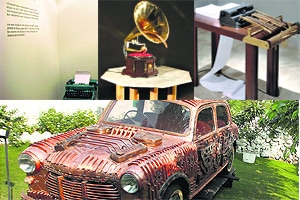REUSE VALUE
We announced their death and brusquely moved on. But objects that have moved out of daily life are finding their way into artists imagination

We announced their death and brusquely moved on. But objects that have moved out of daily life are finding their way into artists imagination
It isnt uncommon to see artists strolling through Friday flea markets looking for inspiration in old and discarded objects. Some realise that a treasured Fiat in the corner of the garage can be elevated to the status of art. The third kind of artists invents their own versions of obsolete telephones,typewriters or Braille machines,with intentions of punning on eccentric relatives,love and other demons. A handpicked selection of these vintage reinventions reveals that some old soldiers never die.
YUSUF ARAKKALS OLD FIAT
The 1956 Fiat Millicento car adorns the garden at Nakul Sens OPalacio in Delhi. Arakkal spent five years stripping his beloved car of its original body and replaced it with one made of gleaming copper and bits of bronze. From hubcap to fender and from the bonnet to the doors,Arakkal and his team of craftsmen toiled to create art on wheels,with a copper tan. I noticed that my Fiat was being neglectedit was my first car. I had bought it with money from two paintings sold to collector Harish Padmanabha, says Bangalore-based Arakkal. I drove it out of his garage after I haggled a bit with him over the price, says Arakkal. His work leaves the viewer mulling over the transition the car has made from a utility object to artwork,one with life in the aesthetic realm.
monthly limit of free stories.
with an Express account.
SUDARSHAN SHETTYS LOUDMOUTH GRAMOPHONE
Mumbai-based Shetty is known for his love of obscure objects. He enjoys playful encounters with found objects to invent a third meaning from combining two objects, a style he is known for. The gramophone was part of a larger significant show Consanguinity (2003) that was shown all over the country and in Japan. The installations include a macabre row of scissors clicking in a bathtub,an old French horn spewing blood and a set of Cellos screeching atonal sounds. These are the more unsettling aspects of the show,but Shettys tongue-in-cheek gramophone stares cheekily at the viewer,rolling its wooden tongue around the gleaming circumference of the horn. In a more recent exhibition,titled Love,which showed at the Bodhi Art Gallery,Shetty installed an old Braille machine to type out love letters that only the blind could read. A pun on love is blind?
THE UNCLE PHONE
This work is by artist duo Søren Pors and Aparna Rao,who are yet to debut in Indiathey have a show slotted for 2011with the Vadhera Art Gallery. This work was inspired by my uncles peculiar habit of asking people to do things for him that he can do himself,such as dialing the number on a landline telephone,while he only listens, says Rao. The two-metre long,red phone needs two people to operate it: one to dial and another to speak. Although seemingly irrational,it reintroduces social manners and etiquette into a highly functional system, says Rao. This is only one example of the artists collection exploring various ways of illuminating unspoken interpersonal relations.
SUCHITRA GAHLOTS CRYING GAME
What this Delhi-based young artist was looking for was a thousand replies from people about why they last cried. I decided to use a vintage typewriter for the task of collecting their one-line replies because it went well with the notion of something dysfunctional and relegated to the corner, says Gahlot,a self-taught artist whose installations got her noticed at the India Art Summit last year. Gahlot collected the typed notes and stuck them on 10 ml bottles,which were then filled with artificial tears. This project was conceptualised at three levels: the physical installation,the virtual website and a limited edition of use and throw books.